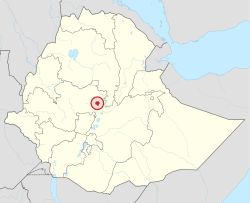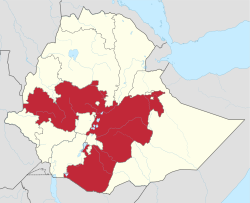Regions of Ethiopia
This article has multiple issues. Please help improve it or discuss these issues on the talk page. (Learn how and when to remove these messages)
|
| Regional states and chartered cities of Ethiopia | |
|---|---|
 | |
| Category | Federation |
| Location | Federal Democratic Republic of Ethiopia |
| Created |
|
| Number | 12 regions, 2 chartered cities (as of 2025) |
| Government |
|
| Subdivisions | |
 |
|---|
Ethiopia is a federation subdivided into ethno-linguistically based regional states (Amharic: plural: ክልሎች kililoch; singular: ክልል kilil; Oromo: singular: Naannoo; plural: Naannolee) and chartered cities (Amharic: plural: አስተዳደር አካባቢዎች astedader akababiwoch; singular: አስተዳደር አካባቢ astedader akabibi). This system of administrative regions replaced the provinces of Ethiopia in 1992.[1]
As of August 2023, there are twelve regional states and two chartered cities (Addis Ababa and Dire Dawa). Being based on ethnicity and language, rather than physical geography or history, the regions vary enormously in area and population; the most notable example is the Harari Region, which has a smaller area and population than either of the chartered cities.
Governance
[edit]The regions are each governed by a regional council whose members are directly elected to represent woredas (districts). Each council has a president, who is elected by the council. Each region also has an executive committee, whose members are selected by the president from among the councilors and approved by the council. Each region has a sector bureau, which implements the council mandate and reports to the executive committee.[2]
History
[edit]Ethiopia was historically divided into provinces. The current system of administrative regions was introduced in 1992 by the Transitional Government of Ethiopia, and was formalised in 1995 when the current Constitution of Ethiopia came into force.[1]
There were 13 regions initially, but five regions were merged to form the multi-ethnic Southern Nations, Nationalities, and Peoples' Region later in 1992, following the first elections of regional councils on 21 June 1992.[3] The country's capital Addis Ababa, and Dire Dawa became chartered cities in 2004.
New regions
[edit]During the premiership of Abiy Ahmed, several new regions have been created.
In November 2019, a referendum was held in the Sidama Zone of the Southern Nations, Nationalities, and Peoples' Region, in which voters supported a proposal for Sidama Zone to become a region in its own right.[4] The Sidama Region was created in June 2020.[5]
The South West Ethiopia Region was created on 23 November 2021 following a successful referendum earlier that year. The new region was split off from the SNNPR and consisted of Keffa, Sheka, Bench Sheko, Dawro, and West Omo Zones, along with Konta special district.[6]
On 19 August 2023 the South Ethiopia Regional State created following the 2023 South Ethiopia Region referendum with the remainder becoming the Central Ethiopia Regional State, thus dissolving the SNNPR.[7]
List of regions and chartered cities
[edit]| Flag | Name | Population (2024)[8] | Area (km2)[9] | Population density (per km²) | Capital | Map |
|---|---|---|---|---|---|---|
| Addis Ababa (city) | 5,704,000 | 527 | 10,823.71 | Addis Ababa | 
| |
| Afar Region | 3,350,000 | 72,051 | 46.48 | Semera | 
| |
| Amhara Region | 32,456,300 | 154,709 | 209.78 | Bahir Dar | 
| |
| Benishangul-Gumuz Region | 1,251,000 | 50,699 | 24.68 | Asosa | 
| |
| Central Ethiopia Regional State | 10,561,000 | 15,098.97 | 699.59 | Hosaina | 
| |
| Dire Dawa (city) | 551,000 | 1,559 | 353.32 | Dire Dawa | 
| |
| Gambela Region | 525,000 | 29,783 | 17.63 | Gambela | 
| |
| Harari Region | 283,000 | 334 | 847.31 | Harar | 
| |
| Oromia Region | 40,884,000 | 284,538 | 143.72 | Addis Ababa | 
| |
| Sidama Region | 5,301,868 | 12,000 | 441.82 | Hawassa | 
| |
| Somali Region | 6,657,000 | 279,525 | 23.82 | Jijiga | 
| |
| South Ethiopia Regional State | 7,584,741 | 45,209.26 | 167.73 | Wolaita Sodo | 
| |
| South West Ethiopia Peoples' Region | 4,197,164 | 39,400 | 106.53 | Bonga | 
| |
| Tigray Region | 6,838,000 | 50,079 | 136.48 | Mek'ele | 
|
See also
[edit]- List of governors of the Regions of Ethiopia
- Flags of the regions of Ethiopia
- List of Ethiopian regions by Human Development Index
- ISO 3166-2:ET
- Subdivisions of Ethiopia
- List of Ethiopian regional states by population
Notes
[edit]References
[edit]- ^ a b Mulatu Wubneh (2017). "Ethnic Identity Politics and the Restructuring of Administrative Units in Ethiopia". International Journal of Ethiopian Studies. 11 (1 & 2): 105–138. JSTOR 26586251.
- ^ Yilmaz, Serdar; Venugopal, Varsha (2008). Local Government Discretion and Accountability in Ethiopia (PDF). Working Paper 08-38. International Studies Program, Andrew Young School of Policy Studies, Georgia State University. pp. 4–5. Archived from the original (PDF) on 20 October 2013. Retrieved 22 June 2013.
- ^ Lyons, Terrence (1996). "Closing the Transition: The May 1995 Elections in Ethiopia". Journal of Modern African Studies. 34 (1): 135. doi:10.1017/S0022278X00055233. JSTOR 161741. S2CID 155079488.
- ^ "The Sidama have voted for their own state. So what next?". 4 December 2019.
- ^ Abdu, Brook (20 June 2020). "Sidama embarks on statehood". The Reporter. Retrieved 22 November 2020.
- ^ "South West Ethiopia Peoples Region Officially Established". MSN Africa. Addis Ababa. Ethiopian News Agency (ENA). 23 November 2021. Retrieved 28 November 2021.
- ^ "Ethiopia's two new regional states formed : Central Ethiopia, South Ethiopia". August 20, 2023.
- ^ "Population Size by Sex Zone and Wereda July 2023" (PDF). Ethiopian Statistical Service. August 2023. Retrieved 19 August 2023.
- ^ "2011 National Statistics" (PDF). Central Statistical Agency. Archived from the original (PDF) on 2015-09-23. Retrieved 2014-12-10.
